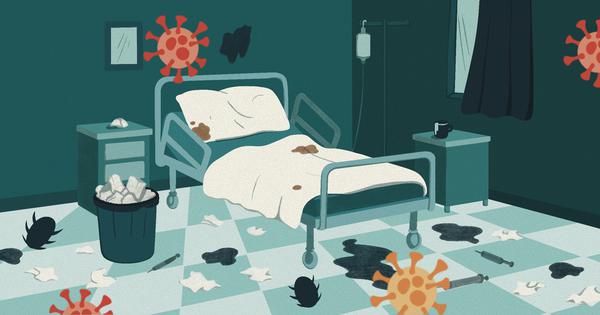
In 1989, Dr Narin Sehgal got a licence to open a five-bedded nursing home in Delhi’s Paschim Vihar – without having to establish any infection control protocols.
“We had learnt about basic sterilisation, cleanliness, donning, and the importance of cleaning the body before surgery in medical college,” Sehgal said. “But we knew nothing beyond that about infection control.”
Nursing homes that ran out of residential buildings did not even have space for infection control, he noted. “I realised everybody practiced infection control differently. It was arbitrary,” he said.
In 2005, the National Accreditation Board for Hospitals was formed to improve healthcare quality in India by laying down standards for certification.
An NABH accreditation is not mandatory, but it is much coveted. The same year, Sehgal decided to get his nursing home accredited – it would improve his nursing home’s rating and draw more patients.
By then, it had expanded into a 30-bed facility – without any official scrutiny of its infection practices.
Applying for the accreditation opened Sehgal’s eyes to the shortcomings in his nursing home’s infection protocol.
For instance, the nursing home had a small room with a steriliser machine and a wash basin where sterilised and non-sterilised instruments would often mix. NABH told Sehgal he would have to convert it into a central sterile services department to segregate sterilised linen and instruments from unsterilised ones.
Sehgal worked hard at measuring up to the NABH requirements, but he failed to get accreditation because of inadequate infrastructure.
“I decided to acquire more space to set up a central sterile services department, an X-ray room and an operation theatre in order to meet NABH standards,” he said.
In 2014, he applied again. In 2016, he received NABH accreditation for his now 100-bedded facility.
The hospital’s infection control nurse Priti Rajput said they purchased “one of the best” plasma sterilisers at a cost of Rs 65 lakh. “Infection control requires investment. Our HAI [healthcare-associated infection] rates are much below the benchmarks,” she said.
Sehgal added: “I believe those without accreditation should not be allowed to operate at all. That is the only way to ensure good practices.”
In this report – the third and final part of our series on healthcare-associated infections – we look at how zero regulation in India makes it easier for hospitals to evade compliance on infection protocols.
No law, no regulation, and no punitive action
The Ministry of Health and Family Welfare has no system to monitor infection rate in hospitals. It has not made it mandatory for a hospital or nursing home to have a standard infection control protocol.
“When a hospital is set up, overall infection control practices are not assessed at the time of giving registration licence,” said Dr Narendra Saini, chairman of the Indian Medical Association’s antimicrobial resistance standing committee. Currently, only biomedical waste management and pollution norms are assessed at the time of registration by local civic bodies.
In 2010, the Clinical Establishments Act was enacted to lay down minimum standards for a hospital to operate. This included adherence to certain infection control protocols.
But in the two decades since, the Act has been implemented by only 19 states. Even in those states, experts said hospitals or nursing homes are rarely held to account under the law.
Unless hospitals opt for accreditation from the National Accreditation Board of Hospitals, the principal accreditation body for hospitals, they have no obligation to implement any form of infection control, Saini said. Infection control is a core part of the NABH’s assessment.
Of India’s 70,000-odd hospitals, only 2,700 have NABH accreditation.
In a response to Scroll’s Right to Information request, Quality Council of India, which heads the NABH, said they provide accreditation for four years to hospitals.
In that duration, at least three inspections are carried out. For renewal, a hospital has to undergo intensive assessment. Such monitoring ensures hospitals follow infection control norms.
“That does not mean [hospitals without NABH accreditation] don’t have infection control protocols,” Saini said. “They do, but to what extent, we have no idea.”
He added that nursing homes are completely out of scrutiny because of their limited resources and zero monitoring by the government.
Many pointed out that the lack of regulatory oversight means there is no incentive for hospitals to invest in infection control. “If you do it (implement infection control), nobody is checking whether you are doing it the right way, and if you don’t do it, nobody is going to pull you up,” said Dr Vijaya Patil, who heads the infection control committee at Tata Memorial Hospital, India’s largest cancer institute.
NABH CEO Dr Atul Mohan Kochhar said there is a strong case to make some kind of quality control mandatory. “Third party oversight makes infection control uniform, precise, and ensures fidelity,” he said.
“There has to be a law in this regard,” he added. “But because health is a state subject, there is a discord.”
No scrutiny from insurance sector
India not only lacks strong government regulation of hospital-acquired infections, even the health insurance sector, increasingly a major player in the country’s hospitals, fails to act as a watchdog.
In the United States, the two government insurance programs – Medicare and Medicaid – refuse to reimburse a hospital the extra treatment cost incurred due to a hospital acquired infection. The hospital is not allowed to pass this extra cost to the patient.
“That is a strong incentive for hospitals to prevent such infections from happening in the first place,” said Dr Sanjay Nagral, surgeon and the chairperson of Forum for Medical Ethics Society.
In India, there is no such system in place. Two insurance agents told Scroll that insurance companies largely cover the additional cost incurred due to hospital acquired infection. In rare cases where they refuse to reimburse, a patient has to foot the bill.
Milind Gurav, associated with Tata AIG insurance, said their policy allows the additional cost up to the total sum insured if the patient’s condition becomes severe due to complications arising out of treatment. “We approve a certain amount. But that amount can be increased if the hospital justifies the treatment. Hospital-acquired infections are covered too,” he said.
Tejas Shah, a financial advisor, said his clients with private insurance have never faced any trouble in getting insurance payment for an infection that occurred in the hospital during treatment.
Patil, head of infection committee in Tata hospital, pointed out that the lack of financial responsibility makes hospitals lax in their approach towards infection control. “If insurance companies refused to foot the bill, like in the US, hospitals would become more accountable,” she said.
While insurance companies have data of individual hospitals and their infection rates in the US, in India such data is not maintained by insurance companies.
Kochhar of NABH said discussions have begun in the central government to track data and standards maintained by hospitals. “Ayushman Bharat Digital Mission is a step towards that. There is a central push to collate data and hospital infection control is going to be a key component,” he said.
Ayushman Bharat Digital Mission is an attempt to digitalise the healthcare sector in India by registering hospitals, nursing homes, doctors and creating a database where patients’ files can be accessed online.
Kochhar also points towards the changing awareness around infection control. “Twenty years ago, there were no quality control managers in hospitals. Now there are,” he said.
Government hospitals are also waking up to the need for infection control. At least 18 AIIMS have applied for NABH accreditation. “Soon HAI will become a key component for insurance companies and the government to track,” Kochhar said.
Until that happens, infection control will remain an arbitrary and voluntary exercise.
Read the other parts of this series here.
Silent killers are stalking Indian hospitals. Who is responsible?
This reporting was supported by a grant from the Thakur Family Foundation. Thakur Family Foundation has not exercised any editorial control over the contents of this article.
📰 Crime Today News is proudly sponsored by DRYFRUIT & CO – A Brand by eFabby Global LLC
Design & Developed by Yes Mom Hosting






